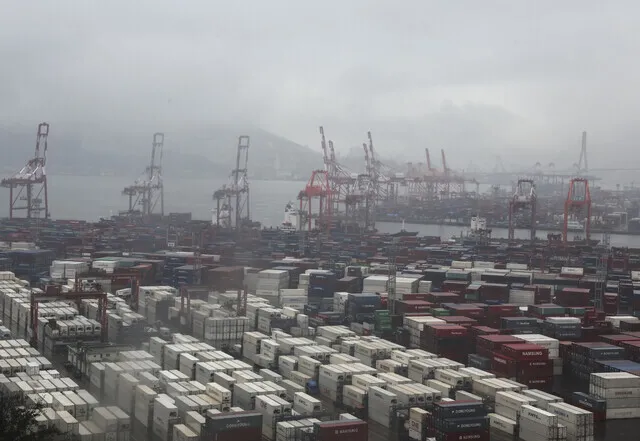hankyoreh
Links to other country sites 다른 나라 사이트 링크
Korea records first trade deficit with China since 1992

South Korea’s monthly export volume has increased for the third month in a row. Along with the base effect, the main factors behind the increase are a rebound in semiconductors and strong performance in automobile exports.
Last year’s exports were down 7.4% from the previous year, the first decline in three years. Because of a slump in exports to China, Korea posted its first trade deficit with China since the two countries established diplomatic relations in 1992.
According to import and export figures for December 2023 and the year as a whole released by the Ministry of Trade, Industry and Energy on Monday, Korea’s exports for December were up 5.1% from the same month in 2022, representing the third consecutive month of year-over-year growth.
Korea’s exports of semiconductors, a key export item, jumped 21.8% from the same month in 2022, increasing for the second month in a row, while automobiles also posted double-digit growth (17.9%).
Import volume fell by 10.8% over the same period. Korea posted a trade surplus of US$4.48 billion in December, making for seven consecutive months of surplus since June.
Semiconductor exports have been on the rise since November of last year. The back-to-back months of rising exports were led by decreasing production of memory semiconductors, a major export item, and growing demand for high value-added products.
The sector’s recovery has been highly elastic, bouncing up by 12.9% in November and then by 21.8% in December.
Total annual semiconductor exports fell by 23.7% last year.
Throughout the year, automobiles almost singlehandedly shored up the otherwise stagnant export performance. Last year’s automobile export dollar value was up by 31.1% from the previous year’s record high.
General machinery exports were up by 4.6%, while ship exports rose by 20.9%. For the remaining 12 of the 15 major export products, annual exports showed negative growth.
Total exports for 2023 stood at US$632.69 billion, which was down 7.4% from the year before. It marked a second major decline in three years, following the one in 2020 as the shockwaves of the COVID-19 pandemic first hit.
In 2023, exports were generally low for the first half of the year and high for the second, without major swings. During the first half of the year, South Korean export areas outside of automobiles struggled with factors including poor semiconductor market conditions and China’s sluggish economic recovery.
In the fourth quarter, exports began showing signs of recovery as semiconductors bounced back, thanks in part to the baseline effect from the previous year’s negative growth. Exports as a whole showed a trend of increase starting in October, with three consecutive months of positive growth.
Annual imports last year totaled US$642.67 billion, a decrease of 12.1% from the year before. The decline in imports far exceeded the drop in exports. In terms of last year’s trade balance, this has translated into a trend of recessionary trade surplus for seven straight months since June 2023.
The annual trade balance last year was in the negative column by US$9.97 billion, although the scale of the deficit was down considerably from the US$47.78 billion recorded for 2022.
Exports to China fell by 19.9% last year owing to factors including sluggish recovery conditions there, declining intermediate goods exports, and a general shift of businesses away from China.
The negative trade balance with China was the first in the 31 years since the two sides formed diplomatic relations in 1992. But while the rate of decrease in exports to China was in the double digits for the first three quarters of 2023, it improved to single digits in the fourth.
In December, monthly exports to the US surpassed those to China. The last time this happened was over 20 years earlier, in June 2003.
In terms of annual exports, the gap between those to China (19.7%) and the US (18.2%) shrunk substantially. The situation restored the US to the status of South Korea’s second-ranked export market for the first time in 19 years since 2005, thanks to booming exports in areas such as electric vehicles and rechargeable batteries.
By Kim Hoe-seung, senior staff writer
Please direct questions or comments to [english@hani.co.kr]

Editorial・opinion
![[Editorial] Constitutional Court must at long last remove Yoon [Editorial] Constitutional Court must at long last remove Yoon](https://flexible.img.hani.co.kr/flexible/normal/500/300/imgdb/original/2025/0402/2617435819121664.jpg) [Editorial] Constitutional Court must at long last remove Yoon
[Editorial] Constitutional Court must at long last remove Yoon![[Column] Don’t let insurrectionists gaslight you [Column] Don’t let insurrectionists gaslight you](https://flexible.img.hani.co.kr/flexible/normal/500/300/imgdb/original/2025/0331/1917434093426857.jpg) [Column] Don’t let insurrectionists gaslight you
[Column] Don’t let insurrectionists gaslight you- [Column ] The obscenity of Trump’s ‘hasbara’
- [Column] In the name of Korean democracy, I rebuke Yoon Suk-yeol!
- [Column] A country free from the threat of military coup d’etats
- [Column] The world without America
- [Column] Lessons for Korea from America’s Chinese Exclusion Act
- [Editorial] Fear of far-right violence grows as verdict on Yoon’s impeachment is delayed
- [Column] The defeat of America
- [Column] Standing atop the ruins of Korean democracy
Most viewed articles
- 1The case against Yoon: 5 counts court will weigh in climactic decision on his impeachment
- 2Arrests, deportations of US green card holders send chill through Korean community
- 3Yoon’s day of reckoning: Experts predict court will oust impeached president on Friday
- 4Embassies in Korea warn of social disturbances ahead of impeachment ruling
- 5What the timeline of a snap Korean presidential election might look like if Yoon is ousted
- 6Understanding the Constitutional Court’s standards for upholding impeachment
- 7Korea has an FTA with US, Japan doesn’t – guess which faces higher tariffs under Trump
- 8It’s time Korea prepares itself for a peninsula without the US, expert advises
- 9Trump slaps 25% tariff on all Korean goods imported to US
- 10[Column ] The obscenity of Trump’s ‘hasbara’